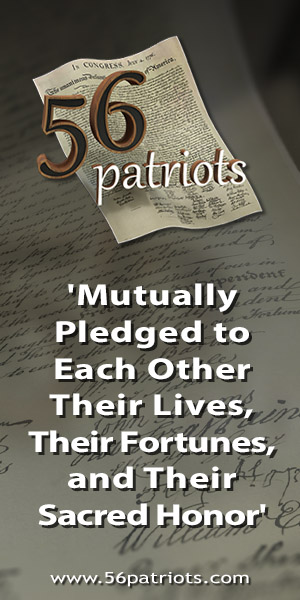The Human Touch Revealing All that is Real
Part I - ANATOMY of a SUPREME COURT CASE: District of Columbia v. Heller (2008)
Publisher's note: This begins the first part of this multi-part series by Diane Rufino examining District of Columbia v. Heller (2008). Part I and all succeeding parts of this mammoth treatise can be found here.
The case District of Columbia v. Heller is the landmark Supreme Court case decided in 2008, and written by the late great conservative Justice Antonin Scalia, which finally looked at the roots and origins of the Second Amendment and ruled that it confers not only a collective right to keep and bear arms when serving in a militia but also an individual right to keep and bear arms for self-defense and for self-protection. The Second Amendment recognizes and guarantees gun rights for two articulated purposes. Both purposes involve self-defense and protection: The first is for the defense and protection of the state and the second is for the defense and protection of the individual.
We the People have the inalienable Right to Life. The corollary to that absolutely fundamental right is the right to defend and preserve it. Otherwise the right is only one recognized on paper. The right to defend one's life implies that the individual be entitled to possess the same type of weapons, and of the same force, which may attempt to take his or her life.
The case stems from an incident, as we will see, that occurred in 1975 and which immediately resulted in the strictest gun control law in the nation - in the District of Columbia.
But first, let's look at the wording of the Second Amendment:
"A well-regulated Militia, being necessary to the security of a free State, the right of the people to keep and bear Arms, SHALL NOT be infringed."
Next, let's look at the context in which this Amendment has been added to the Constitution. To do that, let's look at the Preamble to the first ten amendments (Bill of Rights):
"THE Conventions of a number of the States having at the time of their adopting the Constitution, expressed a desire, in order to prevent misconstruction or abuse of its powers, that further declaratory and restrictive clauses should be added: And as extending the ground of public confidence in the Government, will best insure the beneficent ends of its institution."
Each of the first ten amendments to the Constitution (The Bill of Rights) holds a particular significance in the scope of government. And that significance is articulated by the Preamble which accompanied the Bill of Rights. The Preamble goes to the INTENT of our Founders and framers and to the understanding of the ground rules by which the States established and then agreed to create a general government. Remember, there were several states that would NOT have ratified and adopted the Constitution - that is, would NOT have joined the Union of states - if a Bill of Rights was not added.
How important was the Right to Keep and Bear Arms?? As will be discussed later, gun rights activist Don B. Kates, did extensive research into the history and the roots of our gun rights and the Second Amendment. In his research into the debates of the states in their ratifying conventions (1787-1790), he found that the number of states that recommended adding a guarantee of the right to have guns outnumbered those that recommended adding other rights.
North Carolina was one of those states. North Carolina met in convention in 1788 (July 21 - August 4) and could not decide whether to adopt the US Constitution. The State adopted the Anti-Federalist position which held that the Constitution had the potential of concentrating too much power in a central government. To avoid this, those states argued that a Bill of Rights was needed to be added to the Constitution ("A Bill of Rights is what every free people are entitled to against every government" - Thomas Jefferson). North Carolina decided to wait it out - to see if a Bill of Rights would indeed be added. At that 1788 convention, the delegates drafted and adopted a "Declaration of Rights: (20 of them) and a set of Amendments (26 of them), which were forwarded to Congress. [See https://www.usconstitution.net/rat_nc.html]. One of those "Rights" was the Right to Keep and Bear Arms. It read:
"17. That the people have a right to Keep and Bear Arms; that a well-regulated militia, composed of the body of the people, trained to arms, is the proper, natural, and safe defense of a free state; that standing armies, in time of peace, are dangerous to liberty, and therefore ought to be avoided, as far as the circumstances and protection of the community will admit; and that. in all cases, the military should be under strict subordination to, and governed by, the civil power."
The Constitution was eventually ratified by the requisite nine states on June 21, 1788 (New Hampshire being the ninth state to ratify) and so it went into effect and established our second American Union. The first US Congress was seated on March 4, 1789. (North Carolina was not part of the Union at that time and thus, not represented). In September 1789, the first US Congress adopted a set of amendments (which were written and submitted, as promised, by James Madison), which were sent to the States to be ratified as the US Bill of Rights. Once this was done, North Carolina called up a second convention two months later. The Constitution was ratified on November 21, 1789, making the state the twelfth state to ratify and join the Union.
So, let's go back to 1975, the year that ultimately gave rise to the Heller case.
• Violent crime involving handguns was on the rise in the United States. Communities were no longer safe; the streets were no longer safe. Murders were up, robberies were up, aggravated assaults were up, there were car-jackings, home invasions, drug-related crimes, etc
• In 1974 alone, there were more than 890 incidents of violent crime (involving the illegal use of a firearm) every single day - with a disproportionate share of them being in DC
• In the 1970's, DC was suffering from one of the highest levels of violent crimes (and poverty and drugs and venereal disease) in the country
• Fortune magazine called DC "one of the sickest cities in America"
• The majority of its residents were African-American, trapped in poverty, stuck on welfare, and succumbing to crime and drug use
Prayer was taken out of public schools by the Supreme Court with the Engel v. Vitale ruling in 1962
• Bible readings were taken out of public schools by the Supreme Court with the Abington v. Schempp ruling in 1963
• LBJ signed the Civil Rights Act into law in 1964, creating the welfare system we know today which has had disastrous effects on the advancement of black communities - providing and focusing on handouts that discourage self-improvement, advancement, independency, and responsibility
With respect to LBJ's "War on Poverty" and the "Aid to Families with Dependent Children (AFDC)" program (welfare, particularly aimed at inner-city blacks), Derryck Green, spokesman for Project 21 (Black Leadership Network) explained: "The disastrous effects of the government's management of anti-poverty initiatives are recognizable across racial lines, but the destruction is particularly evident in the black community. It effectively subsidized the dissolution of the black family by rendering the black man's role as a husband and a father irrelevant, invisible and - more specifically - disposable. The result has been several generations of blacks born into broken homes and broken communities experiencing social, moral and economic chaos. It fosters an inescapable dependency that primarily, and oftentimes solely, relies on government to sustain livelihoods." The unintended consequences - institutionalized poverty, crime, drugs, broken families, lack of education, etc were prevalent in DC in the 1970's.
On a Sunday in June 1975, two men broke into a hardware store with pistols and committed armed robbery, firing shots at the guards while customers were in the store. The store was owned by John Hechinger, who also happened to be the first chairman of the Council of the District of Columbia (= city council of DC)
Two years earlier, in December 1973, the US Congress relinquished governance over the District of Columbia and established "home rule," giving the city's residents the right of self-governance.... Finally. However, the government still maintained ultimate authority; it could over-ride laws that it did not approve of.
In July 1976, John Hechinger helped to pass the most stringent gun control law in the nation:
• Banned shotguns completely
• Required that shotguns and rifles must be kept unloaded, disassembled, and locked in one's home
• Long guns (rifles, shotgun) could be assembled for recreation purposes only, such as hunting
• Banned the use of "long guns" (including shotgun) for non-recreational purposes (hence, they could not be used for self-defense)
In other words, even if a person owned a shotgun, he or she couldn't use it against an armed burglar coming through the door.
Interestingly, a young first-term Republican Congressman from southern Texas, Ron Paul, who had a particular aversion to big ambitious government and who would go on to found the Liberty movement, tried to over-turn the gun ban in Congress. Although Congress had given DC "home rule," it still retained the right to revise its laws should it feel the need to do so. [The bill passed; however, the wording was so sloppy that it was ineffective at overturning the ban].
When the DC gun ban went into effect, Second Amendment jurisprudence wasn't very well-articulated. The prevailing view was that the Second Amendment articulated a "militia theory" of gun rights. That is, a "collective right." Only when an individual was serving or able to serve in a state militia would he be entitled to keep and bear arms. Those arms, accordingly, would only be allowed when serving in a militia.
In 1939, the Supreme Court ruled in the case United States v. Miller that "a sawed-off shotgun is not a typical weapon used by a militia and thus is not protected under the Second Amendment," thus apparently endorsing the "militia theory" or "collective right" view of the Second Amendment.
Note that the Supreme Court never really officially endorsed the "Militia" theory (or Collective Right theory) of the Second Amendment because it never bothered to do a deep dive into its history or original meaning, but it certainly appeared it tended that way in 1939 with the Miller case. For many decades after the opinion, the lower federal courts adopted the "militia theory" and the Supreme Court never objected or took cases to correct this view. In fact, the justices of the Supreme Court declined for 70 years to rule on any Second Amendment case.
In the 1930's and 1940's, and even into the 1960's, the US practiced and even institutionalized civil rights violations against African-Americans. There was the Jim Crow era, followed by the violent Civil Rights era, when those institutions of racism finally came toppling down. Before that, freed slaves and their children were victimized and persecuted by the Democratic Ku Klux Klan - militant members of the Southern Democratic Party intent on maintaining white supremacy in the South by preventing blacks from voting and having any meaningful civic voice in southern society. Most people don't know that one of the primary objects of the Ku Klux Klan was to visit the homes of freed blacks and take their guns away. Blacks could not be permitted to have firearms; they could not be permitted to defend themselves or to harm whites.
In the summer of 1963, a gun-rights activist named Don Kates stood guard outside the home of a local civil rights activist in eastern NC with an M1 Carbine in one hand and a Smith & Wesson Chief's Special revolver in the other hand. That activist, a woman, was to be a plaintiff in a civil rights lawsuit and she had been receiving death threats. Eastern North Carolina was Ku Klux Klan country and the police too often sided with the Klan. Good men, civilians, armed with firearms would have to protect her and Don Kates volunteered for the job. Kates had just completed his first year at Yale Law School and was volunteering at a law firm in North Carolina working on civil rights cases. The experience of providing protection for a woman facing death threats taught Kates a valuable lesson: For oppressed people who can't rely on the police, having a gun is sometimes the only means of self-protection. This was especially true for African-Americans who had a history of being oppressed and being denied access and ownership of guns. [Adam Winkler, "Gun Fight: The Battle Over the Right to Bear Arms in America." (2011)]
Later in the 1970's when he went into private practice, Kates began to represent clients in civil rights cases. To best do so, he researched the history of the Second Amendment. Eventually, over the next couple of years, he published a series of articles in various legal magazines and journals on gun rights, the most notable being the Michigan Law Review. [Don Kates, "Handgun Prohibition and the Original Meaning of the Second Amendment," Michigan Law Review 82 (1983): 204]. That article in the Michigan Law Review was the first article ever to appear in a law review from a top ten law school arguing that the Second Amendment protected an individual right to keep firearms for self-defense. This article would help revolutionize Second Amendment jurisprudence by tying it to its original meaning and intent. [Adam Winkler, "Gun Fight...."]
But Kates' article wasn't actually the first to articulate this "Individual Right" view of the Second Amendment. That distinction would belong to Robert Sprecher, a Chicago lawyer, in 1965. Every year, the American Bar Association (ABA) sponsored an essay competition on constitutional law issues. The winning essay is published in the ABA Journal, the most widely-circulated legal periodical. In 1965, the question posed was this: "What does the Second Amendment, guaranteeing the right of the people to keep and bear arms,' mean? Does the guarantee extend to the keeping and bearing of arms for private purposes not connected with a militia?" The winning essay was written by Sprecher (who, incidentally, went on to being nominated to the federal bench by President Nixon). [Robert Sprecher, "The Lost Amendment," American Bar Association Journal 51 (1965)]. In his essay, he argued that the original meaning of the Second Amendment had been lost. According to his research into its historical roots, the Founding Fathers sought to secure "the right to arm a state militia AND also the right of the individual to keep and bear arms" for personal self-protection. [Adam Winkler, "Gun Fight...."]
Go Back
The case District of Columbia v. Heller is the landmark Supreme Court case decided in 2008, and written by the late great conservative Justice Antonin Scalia, which finally looked at the roots and origins of the Second Amendment and ruled that it confers not only a collective right to keep and bear arms when serving in a militia but also an individual right to keep and bear arms for self-defense and for self-protection. The Second Amendment recognizes and guarantees gun rights for two articulated purposes. Both purposes involve self-defense and protection: The first is for the defense and protection of the state and the second is for the defense and protection of the individual.
We the People have the inalienable Right to Life. The corollary to that absolutely fundamental right is the right to defend and preserve it. Otherwise the right is only one recognized on paper. The right to defend one's life implies that the individual be entitled to possess the same type of weapons, and of the same force, which may attempt to take his or her life.
The case stems from an incident, as we will see, that occurred in 1975 and which immediately resulted in the strictest gun control law in the nation - in the District of Columbia.
But first, let's look at the wording of the Second Amendment:
"A well-regulated Militia, being necessary to the security of a free State, the right of the people to keep and bear Arms, SHALL NOT be infringed."
Next, let's look at the context in which this Amendment has been added to the Constitution. To do that, let's look at the Preamble to the first ten amendments (Bill of Rights):
"THE Conventions of a number of the States having at the time of their adopting the Constitution, expressed a desire, in order to prevent misconstruction or abuse of its powers, that further declaratory and restrictive clauses should be added: And as extending the ground of public confidence in the Government, will best insure the beneficent ends of its institution."
Each of the first ten amendments to the Constitution (The Bill of Rights) holds a particular significance in the scope of government. And that significance is articulated by the Preamble which accompanied the Bill of Rights. The Preamble goes to the INTENT of our Founders and framers and to the understanding of the ground rules by which the States established and then agreed to create a general government. Remember, there were several states that would NOT have ratified and adopted the Constitution - that is, would NOT have joined the Union of states - if a Bill of Rights was not added.
How important was the Right to Keep and Bear Arms?? As will be discussed later, gun rights activist Don B. Kates, did extensive research into the history and the roots of our gun rights and the Second Amendment. In his research into the debates of the states in their ratifying conventions (1787-1790), he found that the number of states that recommended adding a guarantee of the right to have guns outnumbered those that recommended adding other rights.
North Carolina was one of those states. North Carolina met in convention in 1788 (July 21 - August 4) and could not decide whether to adopt the US Constitution. The State adopted the Anti-Federalist position which held that the Constitution had the potential of concentrating too much power in a central government. To avoid this, those states argued that a Bill of Rights was needed to be added to the Constitution ("A Bill of Rights is what every free people are entitled to against every government" - Thomas Jefferson). North Carolina decided to wait it out - to see if a Bill of Rights would indeed be added. At that 1788 convention, the delegates drafted and adopted a "Declaration of Rights: (20 of them) and a set of Amendments (26 of them), which were forwarded to Congress. [See https://www.usconstitution.net/rat_nc.html]. One of those "Rights" was the Right to Keep and Bear Arms. It read:
"17. That the people have a right to Keep and Bear Arms; that a well-regulated militia, composed of the body of the people, trained to arms, is the proper, natural, and safe defense of a free state; that standing armies, in time of peace, are dangerous to liberty, and therefore ought to be avoided, as far as the circumstances and protection of the community will admit; and that. in all cases, the military should be under strict subordination to, and governed by, the civil power."
The Constitution was eventually ratified by the requisite nine states on June 21, 1788 (New Hampshire being the ninth state to ratify) and so it went into effect and established our second American Union. The first US Congress was seated on March 4, 1789. (North Carolina was not part of the Union at that time and thus, not represented). In September 1789, the first US Congress adopted a set of amendments (which were written and submitted, as promised, by James Madison), which were sent to the States to be ratified as the US Bill of Rights. Once this was done, North Carolina called up a second convention two months later. The Constitution was ratified on November 21, 1789, making the state the twelfth state to ratify and join the Union.
So, let's go back to 1975, the year that ultimately gave rise to the Heller case.
• Violent crime involving handguns was on the rise in the United States. Communities were no longer safe; the streets were no longer safe. Murders were up, robberies were up, aggravated assaults were up, there were car-jackings, home invasions, drug-related crimes, etc
• In 1974 alone, there were more than 890 incidents of violent crime (involving the illegal use of a firearm) every single day - with a disproportionate share of them being in DC
• In the 1970's, DC was suffering from one of the highest levels of violent crimes (and poverty and drugs and venereal disease) in the country
• Fortune magazine called DC "one of the sickest cities in America"
• The majority of its residents were African-American, trapped in poverty, stuck on welfare, and succumbing to crime and drug use
Prayer was taken out of public schools by the Supreme Court with the Engel v. Vitale ruling in 1962
• Bible readings were taken out of public schools by the Supreme Court with the Abington v. Schempp ruling in 1963
• LBJ signed the Civil Rights Act into law in 1964, creating the welfare system we know today which has had disastrous effects on the advancement of black communities - providing and focusing on handouts that discourage self-improvement, advancement, independency, and responsibility
With respect to LBJ's "War on Poverty" and the "Aid to Families with Dependent Children (AFDC)" program (welfare, particularly aimed at inner-city blacks), Derryck Green, spokesman for Project 21 (Black Leadership Network) explained: "The disastrous effects of the government's management of anti-poverty initiatives are recognizable across racial lines, but the destruction is particularly evident in the black community. It effectively subsidized the dissolution of the black family by rendering the black man's role as a husband and a father irrelevant, invisible and - more specifically - disposable. The result has been several generations of blacks born into broken homes and broken communities experiencing social, moral and economic chaos. It fosters an inescapable dependency that primarily, and oftentimes solely, relies on government to sustain livelihoods." The unintended consequences - institutionalized poverty, crime, drugs, broken families, lack of education, etc were prevalent in DC in the 1970's.
On a Sunday in June 1975, two men broke into a hardware store with pistols and committed armed robbery, firing shots at the guards while customers were in the store. The store was owned by John Hechinger, who also happened to be the first chairman of the Council of the District of Columbia (= city council of DC)
Two years earlier, in December 1973, the US Congress relinquished governance over the District of Columbia and established "home rule," giving the city's residents the right of self-governance.... Finally. However, the government still maintained ultimate authority; it could over-ride laws that it did not approve of.
In July 1976, John Hechinger helped to pass the most stringent gun control law in the nation:
• Banned shotguns completely
• Required that shotguns and rifles must be kept unloaded, disassembled, and locked in one's home
• Long guns (rifles, shotgun) could be assembled for recreation purposes only, such as hunting
• Banned the use of "long guns" (including shotgun) for non-recreational purposes (hence, they could not be used for self-defense)
In other words, even if a person owned a shotgun, he or she couldn't use it against an armed burglar coming through the door.
Interestingly, a young first-term Republican Congressman from southern Texas, Ron Paul, who had a particular aversion to big ambitious government and who would go on to found the Liberty movement, tried to over-turn the gun ban in Congress. Although Congress had given DC "home rule," it still retained the right to revise its laws should it feel the need to do so. [The bill passed; however, the wording was so sloppy that it was ineffective at overturning the ban].
When the DC gun ban went into effect, Second Amendment jurisprudence wasn't very well-articulated. The prevailing view was that the Second Amendment articulated a "militia theory" of gun rights. That is, a "collective right." Only when an individual was serving or able to serve in a state militia would he be entitled to keep and bear arms. Those arms, accordingly, would only be allowed when serving in a militia.
In 1939, the Supreme Court ruled in the case United States v. Miller that "a sawed-off shotgun is not a typical weapon used by a militia and thus is not protected under the Second Amendment," thus apparently endorsing the "militia theory" or "collective right" view of the Second Amendment.
Note that the Supreme Court never really officially endorsed the "Militia" theory (or Collective Right theory) of the Second Amendment because it never bothered to do a deep dive into its history or original meaning, but it certainly appeared it tended that way in 1939 with the Miller case. For many decades after the opinion, the lower federal courts adopted the "militia theory" and the Supreme Court never objected or took cases to correct this view. In fact, the justices of the Supreme Court declined for 70 years to rule on any Second Amendment case.
In the 1930's and 1940's, and even into the 1960's, the US practiced and even institutionalized civil rights violations against African-Americans. There was the Jim Crow era, followed by the violent Civil Rights era, when those institutions of racism finally came toppling down. Before that, freed slaves and their children were victimized and persecuted by the Democratic Ku Klux Klan - militant members of the Southern Democratic Party intent on maintaining white supremacy in the South by preventing blacks from voting and having any meaningful civic voice in southern society. Most people don't know that one of the primary objects of the Ku Klux Klan was to visit the homes of freed blacks and take their guns away. Blacks could not be permitted to have firearms; they could not be permitted to defend themselves or to harm whites.
In the summer of 1963, a gun-rights activist named Don Kates stood guard outside the home of a local civil rights activist in eastern NC with an M1 Carbine in one hand and a Smith & Wesson Chief's Special revolver in the other hand. That activist, a woman, was to be a plaintiff in a civil rights lawsuit and she had been receiving death threats. Eastern North Carolina was Ku Klux Klan country and the police too often sided with the Klan. Good men, civilians, armed with firearms would have to protect her and Don Kates volunteered for the job. Kates had just completed his first year at Yale Law School and was volunteering at a law firm in North Carolina working on civil rights cases. The experience of providing protection for a woman facing death threats taught Kates a valuable lesson: For oppressed people who can't rely on the police, having a gun is sometimes the only means of self-protection. This was especially true for African-Americans who had a history of being oppressed and being denied access and ownership of guns. [Adam Winkler, "Gun Fight: The Battle Over the Right to Bear Arms in America." (2011)]
Later in the 1970's when he went into private practice, Kates began to represent clients in civil rights cases. To best do so, he researched the history of the Second Amendment. Eventually, over the next couple of years, he published a series of articles in various legal magazines and journals on gun rights, the most notable being the Michigan Law Review. [Don Kates, "Handgun Prohibition and the Original Meaning of the Second Amendment," Michigan Law Review 82 (1983): 204]. That article in the Michigan Law Review was the first article ever to appear in a law review from a top ten law school arguing that the Second Amendment protected an individual right to keep firearms for self-defense. This article would help revolutionize Second Amendment jurisprudence by tying it to its original meaning and intent. [Adam Winkler, "Gun Fight...."]
But Kates' article wasn't actually the first to articulate this "Individual Right" view of the Second Amendment. That distinction would belong to Robert Sprecher, a Chicago lawyer, in 1965. Every year, the American Bar Association (ABA) sponsored an essay competition on constitutional law issues. The winning essay is published in the ABA Journal, the most widely-circulated legal periodical. In 1965, the question posed was this: "What does the Second Amendment, guaranteeing the right of the people to keep and bear arms,' mean? Does the guarantee extend to the keeping and bearing of arms for private purposes not connected with a militia?" The winning essay was written by Sprecher (who, incidentally, went on to being nominated to the federal bench by President Nixon). [Robert Sprecher, "The Lost Amendment," American Bar Association Journal 51 (1965)]. In his essay, he argued that the original meaning of the Second Amendment had been lost. According to his research into its historical roots, the Founding Fathers sought to secure "the right to arm a state militia AND also the right of the individual to keep and bear arms" for personal self-protection. [Adam Winkler, "Gun Fight...."]
























